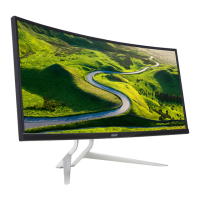
Do you have a question about the Acer XR382CQK and is the answer not in the manual?
| 3D | No |
|---|---|
| HD type | UltraWide Quad HD+ |
| Display diagonal | 37.5 \ |
| Display resolution | 3840 x 1600 pixels |
| Display technology | LED |
| Native aspect ratio | 21:9 |
| Contrast ratio (dynamic) | 100000000:1 |
| Contrast ratio (typical) | - |
| Display number of colors | 1.073 billion colors |
| Viewing angle, horizontal | 172 ° |
| Display brightness (typical) | 300 cd/m² |
| Supported graphics resolutions | 3840 x 1600 |
| Tilt angle range | -5 - 35 ° |
| Product color | Black, Silver |
| Market positioning | Gaming |
| VGA (D-Sub) ports quantity | 0 |
| Power consumption (standby) | - W |
| Power consumption (typical) | 54 W |
| Width (without stand) | - mm |
|---|---|
| Weight (without stand) | - g |
Read instructions carefully for future reference and follow product warnings.
Normal LCD behavior, pixel variations, and image persistence are explained.
Guidelines for cleaning the monitor, including unplugging first.
Ensure power outlet accessibility and ease of disconnection.
Instructions to protect hearing, including volume adjustment.
General safety warnings for product use.
Covers warnings about water, unstable placement, ventilation, foreign objects, liquids, vibration, and power supply.
Guidance on using electrical power safely and correctly.
Lists conditions requiring professional servicing, like damaged cords or spills.
Tips for adjusting viewing angle, posture, and breaks for comfort.
Suggestions to reduce eyestrain, including rest and blinking.
Tips for display cleanliness, positioning, brightness, and glare reduction.
Instructions on how to adjust the monitor's height.
Information on the monitor's tilt range and adjustment.
Describes the functions of the monitor's physical buttons and joystick.
Overview of the OSD main page and its shortcut functions.
Explains how to select game modes and user-defined profiles.
Guides on adjusting and saving brightness settings.
How to adjust monitor brightness from 0 to 100.
How to adjust monitor contrast from 0 to 100.
Adjusts black level for shadow enhancement without affecting lighter shades.
Filters blue light to protect eyes by adjusting its intensity.
Adjusts luminance tone, with default value 2.2.
Options to set color temperature (Cool, Normal, Warm, etc.).
Enables sRGB for better color matching with peripherals.
Adjusts hue for red, green, blue, yellow, magenta, cyan.
Adjusts saturation for red, green, blue, yellow, magenta, cyan.
Adjusts the audio volume level.
Turns DTS Sound On or Off for enhanced audio.
Selects Over Drive setting (Off, Normal, Extreme).
Displays an aim point on screen for shooting games.
Sets the OSD menu language.
Adjusts the delay before the OSD menu turns off.
Selects OSD transparency level for gaming mode.
Displays the current panel refresh rate on screen.
Selects the input source from DP In, HDMI 2.0, HDMI(MHL), or DP ALT.
Enables automatic search for signal source.
Configures monitor daisy-chaining for extend or clone modes.
Selects DP version support (DP1.1 or DP1.2).
Selects screen aspect ratio (Full, Aspect, 1:1).
Configures Picture-in-Picture/Picture-by-Picture modes.
Adjusts lighting effects, color, and style.
Assigns functions to shortcut keys.
Allows PC software to control monitor settings.
Adjusts HDMI black level.
Enables or disables quick boot speed.
Configures DP ALT mode for USB 3.0 and display resolution.
Enables or disables USB charging when the monitor is off.
Lists common problems and remedies for HDMI/DP/DP ALT modes.